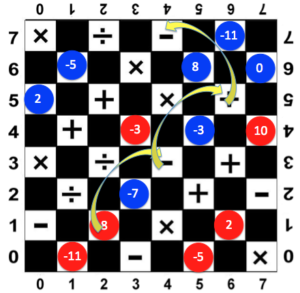Introduction to the DaMath Board Game Part 2
In the first part of this series, we have learned the basics of playing DaMath. We have learned the initial position of pieces on the board, how to move the pieces, how to capture the opponent’s piece, and how to score exchanges. In this post, we are going to learn how to capture multiple pieces.
In DaMath, it is possible to capture multiple pieces. For example, in Figure 1, the Red Player placed 8 on (4,5). Now, the Blue Player is required to capture 8 using 4.
After capturing 8, it is now the Red Player’s turn to capture the Blue Player’s pieces as shown in Figure 2. Although capturing a piece is mandatory, capturing multiple pieces is optional. As shown, the Red Player is required to capture 4 using -5. However, he has also the option to capture -1 or 8. Note that capturing multiple pieces is considered as one move. Here are the possible cases.
Case 1: Red Player captures only 4 using -5 with landing on (4,5). So, the score here is -5 × 4 = -20. This is not a good move because it will add -20 to the Red Player’s score and hence will decrease it.
Case 2: Red Player captures 4 and -1 using -5 as indicated by the arrows. This is considered one move although -5 jumped twice. Here, the score will be -5 × 4 ÷ (-1) = 20. This is an advantage for the Red Player since it will increase his score by 20.
Case 3: Red Player captures 4 and 8 using -5 as indicated by the arrows. Here, the score will be -5 × 4 + 8 = -12. This is not very advantageous, however, it will promote -5 as a dama (roughly equivalent to a queen in chess).
In the second example as shown in Figure 3, it is the Red Player’s move. Notice that he is required to capture -7 but he has the option to capture one more piece or two more pieces in one move as indicated by the arrows. Which do you think is the most advantageous move?
In DaMath, it is important to think before capturing a piece or before making a move to exchange pieces. In every move, it has to be to your advantage; that is, it has to increase your score.
In the next post, we are going to learn how to use a dama.


